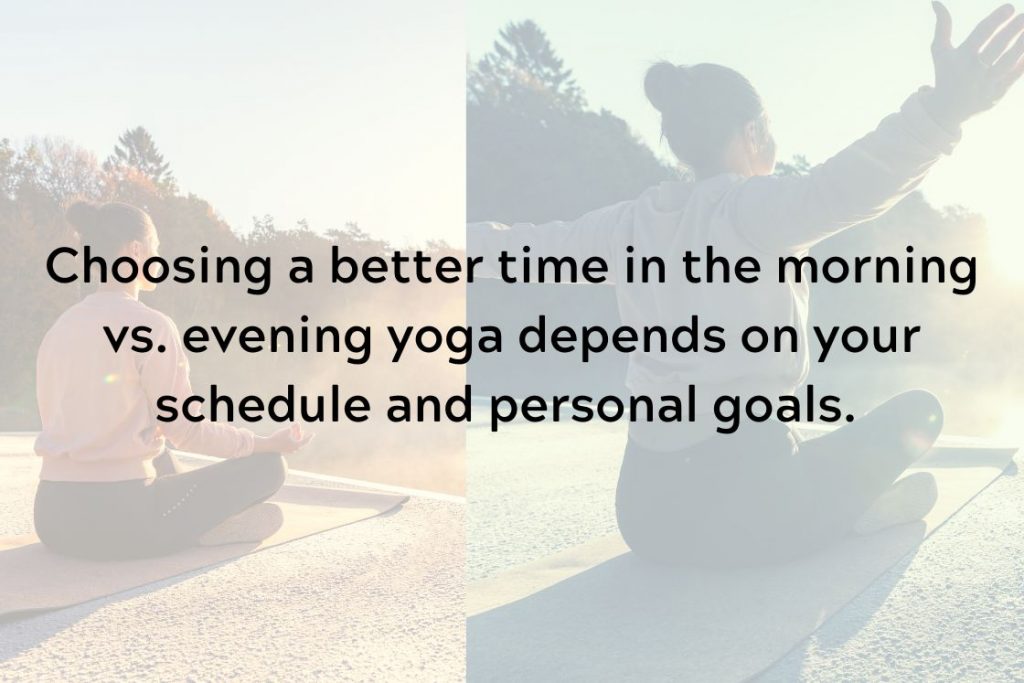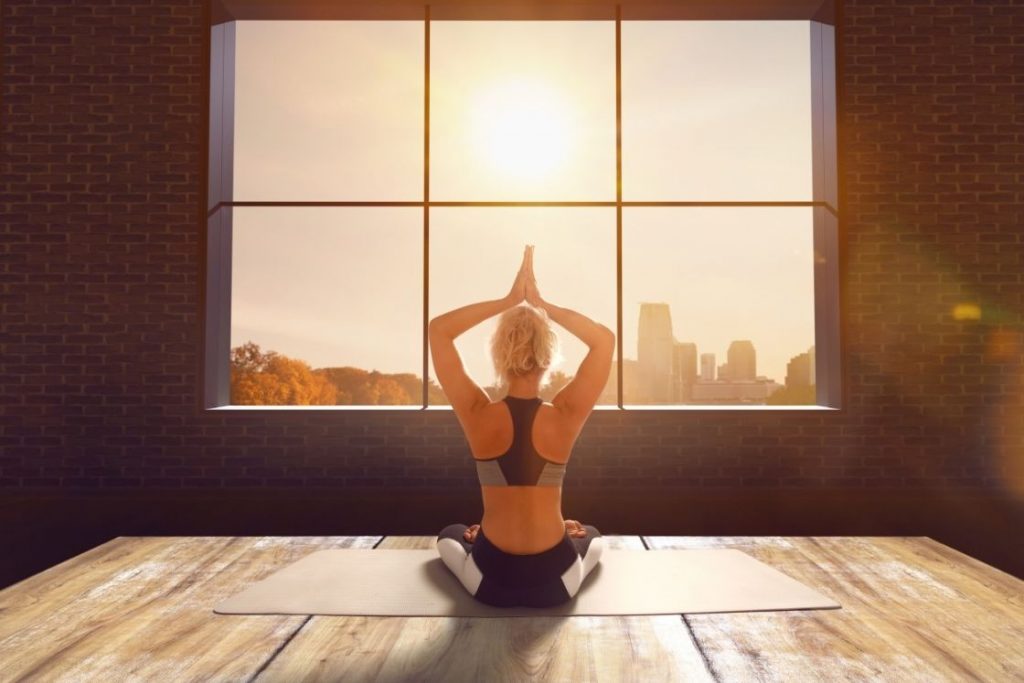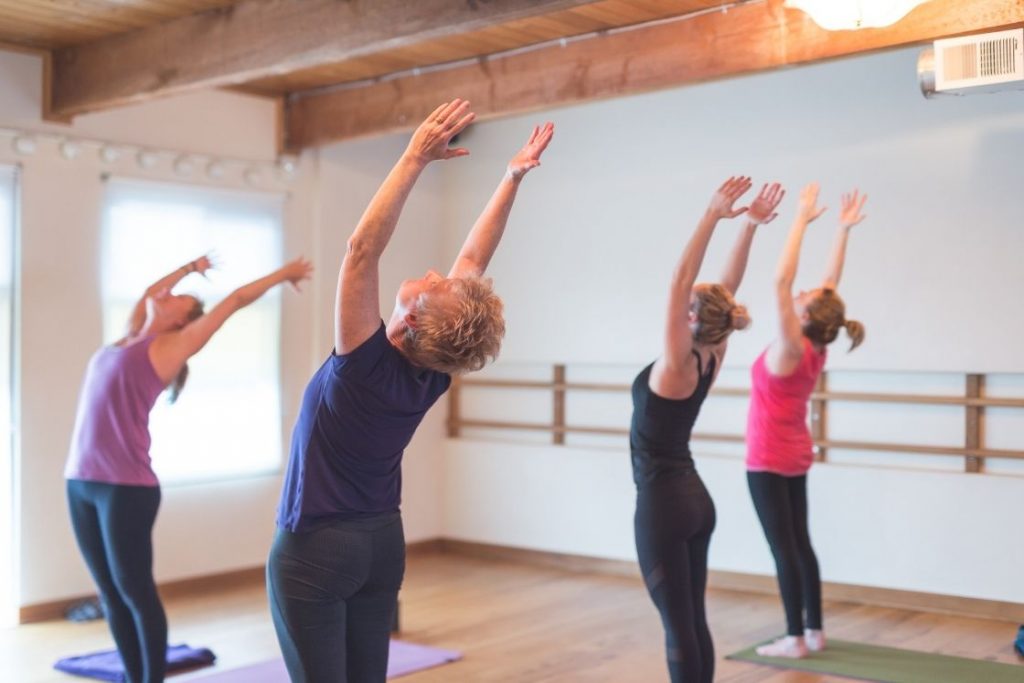- Morning or evening time?
- Yoga in the morning
- Best yoga for mornig
- Yoga in the afternoon
- Yoga in the evening

A common question that may arise when a beginner determines to practice yoga is “what time of the day is best to do yoga”?
Most yoga enthusiasts will advise you to start doing yoga in the early morning, as it energizes your body and set the tone for the rest of your day. You may also hear some people telling that evening or the time before going to bed is ideal as yoga is a form of destressing practice and remove all tension from the mind and body.
Truthfully, there is no right or wrong time to do yoga – the best time is the time that works for you, that fits into your schedule and matches your body’s rhythms.
You can listen to the experts for their input on the best time for yoga practice however, it all boils down to your preference and routine. The key is to maintain a consistent practice to get the optimum results.
In this article, we will look into the question; when one should do yoga? what are the benefits of doing yoga at different times of the day – morning, afternoon, and evening? Eventually, it will help you decide what’s the best time for you.
Which Is A Better Time To Practice Yoga, Morning Or Evening?

Depending on your schedule and personal goals, you may want to do yoga early in the morning or late in the evening.
If you strictly want to follow a traditional yogic lifestyle then the right time to do yoga and meditation is the morning period between 3.30 a.m. and 5.30 a.m. This time period is called Brahma Muhurta which begins exactly 1 hour and 36 minutes before sunrise and ends 48 minutes before sunrise.
But in our modern lifestyle, it may not possible for everyone to wake up this early in the morning and follow traditional yoga advice. So it’s recommended you wake up as early as 6 or 7 a.m., attend nature’s call and then do yoga before eating anything heavy (or breakfast). It can be a perfect morning routine for you as a yogi.
However, if you want to do yoga just as a means of physical and mental exercise, then early morning, as well as late evening, is a good time to practice yoga.
You can do yoga anytime in the evening after you’ve been off your job work, as long as it’s been two to three hours since you’ve had your launch (or last evening meal). Yin yoga, restorative yoga or gentle yoga sequence are generally preferred in the evenings as it relaxes the body and prepares it for rest.
Morning yoga in itself brings a whole bunch of benefits for your mind, body and soul; especially considered good to elevate your spiritual well-being while doing yoga in the evening has its own perks. It helps you ease the stress of the day and makes your mind calm for night’s sleep.
Whatever time you choose to practice yoga, morning or evening, first try out yoga at different times and then let your body and mind choose one time that fits into your daily routine and matches your personal goals. Once you get accustomed to one schedule then make sure to maintain this timing. Ideally, do yoga in the morning between 6 a.m. to 7 a.m. or in the evening from 6 p.m to 7 p.m or half an hour before bedtime.
Maintaining consistency in yoga practice is very important to reap all its benefits in the actual sense.
Also read: 10 tips to stay consistent on your morning yoga routine
Why Is It Good To Do Yoga In The Morning?

It goes without saying that the best time to practice yoga is early in the morning.
Most yogis do their yoga sadhana before sunrise, the time between 3.30 am to 5.30 am, also known as Brahma Muhurta or divine hours of the day. Different yoga styles like ashtanga and vinyasa which emerged from India, even today follow the tradition of conducting yoga classes in the morning.
Doing yoga in the morning has its own perks, it includes:
- Loosens stiff body muscles
- Maintain energy level throughout the day
- Increases metabolism and appetite
- Asana practice empty stomach burn more fat which leads to weight loss
- disciplines body and mind
- Secrets more endorphins or happy hormones
- The natural calmness of environment increases the focus
In the morning, most people have schedules that are quicker or more expected, which can be a catalyst to keeping a steady morning yoga practice. Your day will get off to a good start with a morning yoga session that will allow you to focus better, clear your head, and result in higher levels of energy for the rest of the day.
Which Yoga Is Best For The Morning?
The morning being the time your body is stiffer than any other time of the day, start your practice with slow and warm-up yoga exercises.
So an ideal routine for morning yoga could be like this: first, do a few rounds of basic hatha yoga poses for deep stretching and then pace up your sequence with vinyasa flow to move the energy throughout the body. Incorporate a few minutes of energizing pranayama like kapalbhati and bhastrika after asanas practice. And finally, end your practice with a short mindfulness meditation session.
For morning yoga, you can build up a sequence of asanas that begins with Sun salutation and moves to some backbends, inversions, and twists. The following poses can be incorporated into your morning yoga sequence:
You may also like: 16 warm-up yoga exercises for major body limbs
Doing Yoga In The Afternoon
Afternoon time is generally avoided for yoga practice as you might be tired and hungry, which are tempting offers to skip your yoga session. Moreover, yoga practice during the midday can also drain your energy and you might not be able to concentrate for the remaining duration.
If your morning schedule happens very hectic, then you can consider afternoon time for practice. Yoga in the afternoon will help you get past your midday lull by releasing endorphins. Additionally, it will allow you to relax and think clearly so that you can handle the remaining tasks of the day.
But be sure to wait at least two to three hours after eating if you prefer to do yoga between meals during lunchtime or afternoon.
Practise pausing and breathing slowly into the stomach before eating. One can do Surya Bhedana or ‘right nostril breathing’ in this time to activate the Pingala nadi, the subtle channel running through the body linked to digestion, action, fire and transformation, helping enhance digestive power.
Set up a routine based on your energy level. It’s a good idea to engage in a demanding, rigorous practice during noon time if you have the extra energy. However, it can also be more restorative if you need to decompress toward the close of your workday.
Doing Yoga In The Evening

If you’re not a morning person, practising yoga in the evening can be the next best option for you.
At the end of the day, yoga can be practised anytime; late in the evening after you get off from work or at nighttime before bed. During the evening time, our body is more flexible compared to the morning, making it suitable for vinyasa or movement style practice.
A nightly practice right before bed will prepare your body for a night of deep, restful sleep. Yoga before bedtime helps shift the body’s natural response from “fight or flight” to “rest and digest” for the evening, resulting in improved sleep.
A relaxing yoga routine in the evening might help you unwind and reduce tension.
Evening yoga poses can be used to combat insomnia and reduce daytime stress. Even a nighttime regimen can be changed to help relax more quickly by revitalizing your body and mind.
Additionally, it can make you feel more at peace and help you let go of some of the stress and concerns you’ve been carrying for the whole day. It can even enable you to let go of some aches and pains.
Your day will come to a finish with yoga in the evening. You’ll wake up rested and restored if you’re in a positive mood while you’re going to bed.
Yoga asanas that are calming and restorative such as seated, lying down, forward folds, and twists will help you relax your mind and let go of the stress. Do not practice any backbends or inversions as they will stimulate your mind and body which will disrupt your sleep cycle.
So, What Is the Best Time to Do Yoga?
The practice of yoga is considered beneficial whenever you perform it. Mornings and evenings are both the best times to get on the mat. It all depends on which time works the best for you.
You can try practising yoga at various times to check which is a suitable time for you. If you are a morning person, there is no doubt that your morning yoga practice would be active and cherishing. But if you are not so fond of the mornings, shift your practice to the evening.
A person should refrain from practising yoga after meals. It can cause discomfort, especially in the abdominal bends since the food is still in the process of digestion.
Another important factor is to choose the best time for yoga practice by focusing on your goal. If you wish to practice spirituality and mental exercises, the Brahma Muhurta or time between 4 AM to 6 AM is the best period.
If you are targeting weight loss and building muscle strength, the best time to do yoga is in the morning from 6 AM to 9 AM. However, if your goal is to experience calmness and relaxation, the evening is the best time to practice.
It all leads to one and only factor, that you get to choose your best time to practice yoga. Consider your health, habits, preferences, and lifestyle and go for the time that best suits all these.
Do’s and Don’Ts of Yoga Practice Depending on the Time
Whether you are choosing morning or evening for your yoga practice, it is necessary to follow certain protocols based on the timing. Here is a list of do’s and don’ts while performing yogic exercises.
When doing yoga in the early morning
- Ensure you are active on the mat and for that, empty your bladder and bowel before practice. Practising yoga with a night stomach can disturb your practice.
- If you feel weak while practising, you can have a glass of warm water mixed with honey.
- While practising in Brahma Muhurta, pay attention to slow and mindful practices. Focus more on meditation and breathing exercises as compared to fast-paced postures.
- End your morning yoga session with Shavasana. This will help you relax and rejuvenate.
- Do not shower or eat breakfast 30 minutes after your yoga session.
When doing yoga in the evening
- Do not practice yoga immediately after eating your meals. If you have had a large meal, it is better to wait for at least 3-4 hours until the digestion completes.
- If you are hungry, you can have a subtle snack or green tea before practising yoga in the evening.
- End your evening yoga session with deep relaxation in Shavasana. This will result in deep and undisturbed sleep at night.
- Do not perform strenuous exercises or stretches once you have ended the practice with relaxation.
- Do not have dinner immediately after your evening yoga session.
- You can practice the thunderbolt pose and perform Bhramari pranayama before going to bed.
Conclusion
It is quite easy to understand that each phase of the day has its advantage. And whether you pick mornings, afternoon, or late evenings is up to you.
If you want to destress and remove the tension and tiredness of the day, it is better to set up a gentle yoga routine in the late evenings. But it may also be possible that you are completely exhausted by the end of the day and do not have the energy to even lift a finger.
On the other hand, if you are a morning enthusiast, early morning yoga routines will prove to be extremely beneficial. However, mornings also bring stiffer bodies and sluggishness from a restless sleep.
Whatever time you choose, you should keep in mind that your body is sacred and yoga practice is a special time for you. You should be flexible enough to adapt to your bodily and mental needs.
In the end, the best time to practice yoga is when it helps you the most!




